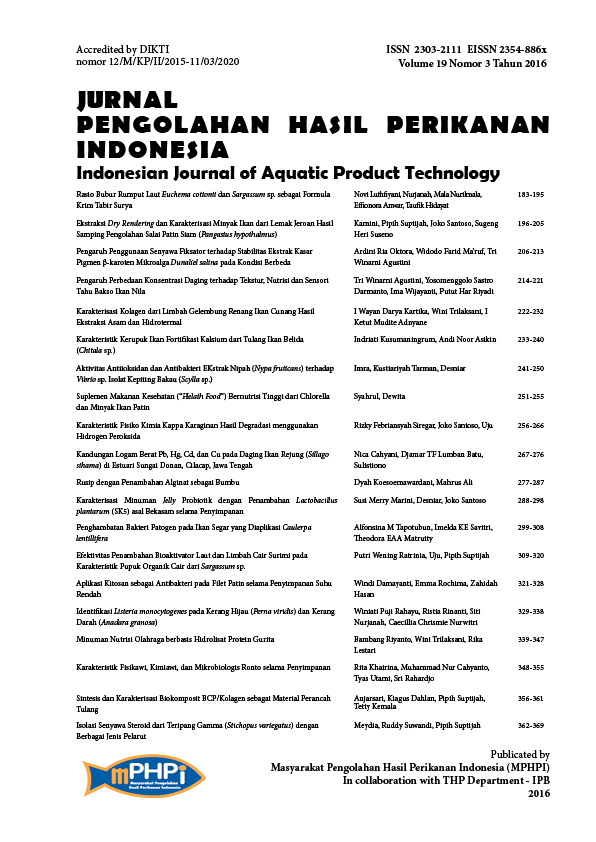Characterization of Collagen from Swim Bladder Waste of Yellow-pike (Muraenesox talabon) by Acid and Hydrothermal Extraction
Abstract
Abstract
Indonesian capture fisheries production reached ± 6.4 million tons in 2014. This number was predicted
resulted a huge fishery waste, one of them was swim bladder that potentially contain collagen, so it needs to
be developed. This aim of this study was to determine the characteristics of the swim bladder (proportion
and chemical content) and collagen characteristics (yield and physicochemical properties) extracted from
the swim bladder cunang (Muraenesox talabon). Swim bladder waste had proportion 0.57 to 0.67% of whole
yellow-piked conger body weight and 24.74% protein/100 g wet weight (equivalent to 93.39% of protein/100
gram dry). The waste had a potency of collagen, which is characterized by the high proportion of the
amino acids glycine, proline, hydroxyproline and alain. Acid extraction and hydrothermal process resulted
collagen extracts, identified from a spectrum of amide I, amide II and amide III functional groups. Collagen
extracted with acid process contained a higher glycine than hydrothermal one, but instead hydrothermal
process produced extract with a higher proline, hydroxyproline and alanine composition.
Indonesian capture fisheries production reached ± 6.4 million tons in 2014. This number was predicted
resulted a huge fishery waste, one of them was swim bladder that potentially contain collagen, so it needs to
be developed. This aim of this study was to determine the characteristics of the swim bladder (proportion
and chemical content) and collagen characteristics (yield and physicochemical properties) extracted from
the swim bladder cunang (Muraenesox talabon). Swim bladder waste had proportion 0.57 to 0.67% of whole
yellow-piked conger body weight and 24.74% protein/100 g wet weight (equivalent to 93.39% of protein/100
gram dry). The waste had a potency of collagen, which is characterized by the high proportion of the
amino acids glycine, proline, hydroxyproline and alain. Acid extraction and hydrothermal process resulted
collagen extracts, identified from a spectrum of amide I, amide II and amide III functional groups. Collagen
extracted with acid process contained a higher glycine than hydrothermal one, but instead hydrothermal
process produced extract with a higher proline, hydroxyproline and alanine composition.
Authors
KartikaI. W. D., TrilaksaniW., & AdnyaneI. K. M. (2017). Characterization of Collagen from Swim Bladder Waste of Yellow-pike (Muraenesox talabon) by Acid and Hydrothermal Extraction. Jurnal Pengolahan Hasil Perikanan Indonesia, 19(3), 222-232. https://doi.org/10.17844/jphpi.v19i3.15074
Authors who publish with this journal agree to the following terms:
- Authors retain copyright and grant the journal right of first publication with the work simultaneously licensed under a Creative Commons Attribution License that allows others to share the work with an acknowledgement of the work's authorship and initial publication in this journal.
- Authors are able to enter into separate, additional contractual arrangements for the non-exclusive distribution of the journal's published version of the work (e.g., post it to an institutional repository or publish it in a book), with an acknowledgement of its initial publication in this journal.





